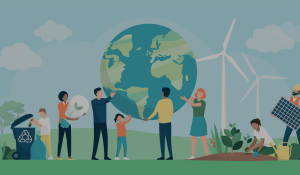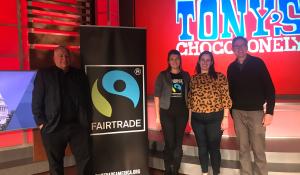
Kristen Suzanne started her green lifestyle years before her daughter Kamea was born. But Suzanne, a raw food chef, realized that “green” took on a whole new meaning when she became a mother—and became fully in charge of keeping little Kamea free from harm. One of the biggest steps she took toward that goal was to ensure she bought eco-friendly clothing for her daughter.
Today, Kamea’s closet is filled with organic cotton, hemp, and bamboo clothing from green retailers, says Suzanne, who looks for deals from green retailers [Editor's note: Parents can also find green bargains at Green America's GreenPages.org.].
“It’s important that I do everything I can to keep my daughter safe while preserving our home for future generations,” says Suzanne. “I don’t want chemical-laden materials touching my baby’s delicate skin, so choosing eco friendly clothing has eased much of my worry about what she is being exposed to.”
Most chemical finishes on conventional clothing fade away with multiple washings, so buying used is still a great way to save resources. But when you need new items, choosing sustainably grown, sewn, and finished children’s clothing made from eco-fabrics can help you protect your children’s health, workers, and the Earth.
Issues with Conventional Fabrics
Most children’s clothing is made of cotton, and if that cotton isn’t organic, it’s been sprayed with dangerous chemicals. For example, the pesticide Aldicarb is acutely poisonous to humans, yet it is still commonly used on cotton fields in 25 countries and the US, according to the Organic Trade Association (OTA).
More than ten percent of the world’s insecticides and 25 percent of pesticides are used in cotton production. While pesticides are removed from finished clothing during processing, says author Debra Lynn Dadd (Toxic Free, Tarcher, 2011), they can harm farm workers and the Earth.
Children’s clothing is also made from other synthetic fibers like polyester and nylon, which are made from petrochemicals that have significant environmental impacts. Nylon manufacturing creates nitrous oxide, a greenhouse gas.
Another artificial fiber of concern is rayon. Since it’s made from wood pulp, old-growth forests are often cleared to make way for the pulpwood plantations. Also, to turn the pulp into rayon, it is treated with toxic chemicals such as sulfuric acid, considered a potential skin, organ, and muscular-skeletal toxicant by the National Institutes of Health—which affects those exposed during manufacturing.
Fearsome Fabric Finishes and Dyes
Green-living expert Annie B. Bond, author of Home Enlightenment (Rodale, 2005), notes that many conventional fabrics are coated with toxins for stain-, fire-, and wrinkle-resistance. These can affect both clothing workers and wearers.
Formaldehyde, a known carcinogen, can be found in some permanent-press and fire-retardant clothing, says Bond—including children’s polyester sleepwear up to size 14, which is legally required to meet federal flammability requirements. Also, perfluorocarbons (PFCs), linked in several studies to hormone disruption, can be found in stain-resistant fabrics.
And heavy metals such as the carcinogens chrome, copper, and zinc are often used in conventional fabric dyes, says OTA spokesperson Sandra Marquardt. “For the consumer, the most toxic part of clothing comes from fabric treatments,” says Bond. “Chemicals that resist flames, moths, stains, soil, and wrinkles have been impregnated into the fabric and are often hard to remove through washing.”
Bond says that the “new” smell in clothing often indicates the presence of these toxins. She recommends soaking new clothes overnight in water and a small box of baking soda, then laundering as usual. If the smell doesn’t go away after washing, neither have the chemicals.
For more information about the toxins used in clothing manufacture, see the Detox Your Closet issue of Green American magazine (Fall 2015).
Labor Practices
Not only does conventional clothing harm the environment, but it can harm the people who make it possible for your child to wear denim jeans and cotton T-shirts.
Each September in Uzbekistan—the second-largest cotton exporter in the world—the government shuts down schools when the cotton season begins. Children as young as seven are forced to pick cotton by hand until the harvest is brought in. Uzbek workers receive little pay and poor quality food and water, and they are often punished if quotas are not met.
While many US retailers have pledged to stop buying Uzbek cotton, popular children’s and youth clothing retailers Gymboree, Abercrombie & Fitch, and Carter's only adopted similar pledges in 2011, after months of activist pressure on the issue, including from Green America.
Also, much of the cheap clothing sold in the US is made in China, where the average hourly rate for a factory worker was $1.36 in 2008, according to the Bureau of Labor Statistics, far below many of the country’s neighbors. Although the wage rate rose to $3.60 by 2017, according to Euromonitor, it is still comparatively low.
Sustainable Fibers
Items made from sustainable fibers are the safest and Earth-friendliest clothing for kids and adults. Here’s what to look for:
- Organic cotton: Organic cotton is grown without the use of chemical pesticides and fertilizers. Be careful of cotton that is described as “undyed,” “untreated,” “natural,” or “green.” These labels are not regulated and are sometimes used to market conventional cotton. Also organic cotton may still be coated with toxic finishes.
- Industrial hemp: Rapidly renewable industrial hemp produces three times more fabric per acre than cotton, and it requires little to no pesticides or herbicides.
- Bamboo: Bamboo is a hardy plant that grows quickly and easily. However, toxic chemicals can be used to turn the plant into what is basically rayon. The US Federal Trade Commission mandates that companies using this process must label their products “rayon made from bamboo,” rather than just “bamboo.” Companies that use an eco-friendlier process may label their clothing as made from “bamboo.” Consumers should note that true bamboo fiber will not feel “silky smooth” like bamboo-based rayon.
- Recycled polyester: Recycled polyester is made from recycled soda bottles, cast-off fabrics, and worn-out garments.
- Wool: Wool is renewable, doesn’t need chemicals to grow, and is naturally fire-resistant. Animal rights activists, however, have expressed concern about “mulesing,” a surgical technique in which farmers remove skin around sheep's buttocks that can become dirty from feces. Farmers say mulesing helps prevent fatal blowfly infestations, but activists say the process is painful and ask shoppers to look for wool from sources that do not use this technique.
- Soy cashmere/silk: This fabric is made of the soy protein fiber left after processing soybeans into tofu, oil, and milk. Look for non-genetically engineered soy.
Other Top Qualities for Eco-Friendly Children's Clothing
Truly eco-friendly clothing will also display the following qualities:
- No chemical finishes: You’ll often have to take a company’s word that its clothes are not treated with chemicals, although as stated earlier, the “new clothing smell” is a common giveaway. One label to look for is the Oeko-Tex Standard, a certification system that limits the use of a list of toxins in everything from raw materials to finished clothes.
- Nontoxic dyes and inks: Most green companies will tout their eco-friendly dyes and inks on clothing labels, but you can call the company if you’re unsure. Another option is to look for “colorgrown” cotton garments, made of undyed cotton that naturally grows in shades of green, brown, beige, and ruby.
- Fair labor practices: Look for a union label to ensure that clothing workers had a voice on the job and earned fair benefits. You can also buy from companies that belong to the Fair Trade Federation, which ensures workers labor under fair, healthy conditions and use green production methods.
- The Global Organic Textile Standard (GOTS): This standard sets both environmental and social criteria for clothing throughout the manufacturing process. GOTS requires that clothing wearing its “organic” label be 95 percent organic and have no toxic dyes or finishes. Manufacturers along the supply chain must comply with GOTS standards to minimize waste and to ensure that workers labor under key norms as established by the International Labour Organisation. Under the Nile and Levana Naturals sell baby clothes and Econscious sells clothing for adults with the GOTS label







